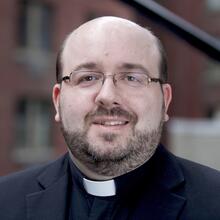Almost all of the secular media’s coverage of “Dignitas Infinita,” the Dicastery for the Doctrine of the Faith’s new declaration on human dignity, led with the paragraphs at the end of the document that criticized gender theory, sex change and surrogacy. Sometimes these accounts noted that the document also reaffirmed the church’s opposition to the death penalty and abortion.
But few of them gave anything more than a brief mention to the other “grave violations of human dignity” with which those topics were grouped, which include: poverty, war, the travails of migrants, human trafficking, sexual abuse, violence against women, euthanasia and assisted suicide, the marginalization of people with disabilities, and digital violence.
All of those topics were in the fourth and final section of the document. Perhaps unsurprisingly, none of the secular coverage I read spent much, if any, time on its introduction and first three sections, which explain how the theological underpinnings of human dignity have been clarified and deepened over time.
Maybe it is understandable—it is certainly predictable—that secular, and even some Catholic, readings focus on the most contentious issues, treating the rest of the document as theological throat-clearing on the way to the “business end” of moral conclusions. But we should not settle for such a narrow reading of the Catholic tradition on dignity.
“Dignitas Infinita,” in its opening sections, presents a kind of case study of the development of doctrine. It tracks what the title of the first section calls “a growing awareness of the centrality of human dignity” from its seeds in classical antiquity, its roots in Scripture, and its development through patristic and medieval theology, the Christian humanism of the Renaissance and even its more secular expressions in the Enlightenment.
Moving into the 20th century, the document notes that reflection on subjectivity deepened the idea of dignity and “enriched contemporary Christian anthropology.” Finally, Vatican II made the concept central to “Dignitatis Humanae,” the declaration on religious freedom.
The final sentence of Section 1 of “Dignitas Infinita” is worth quoting in full: “The church’s magisterium progressively developed an ever-greater understanding of the meaning of human dignity, along with its demands and consequences, until it arrived at the recognition that the dignity of every human being prevails beyond all circumstances.”
Too often, discussion and thinking about development of doctrine can turn into a set of arguments about what can and cannot change in the church’s teaching. Such an approach can lead to an implicit view that “development” is basically a kind of ecclesial power politics by other means, a view that has sadly been in evidence both among some who are hostile to Pope Francis’ magisterium and also among some who expect specific changes from it.
But “Dignitas Infinita” reminds us that development of doctrine is a vital aspect of the church’s theological tradition and a gift to be received gratefully. The centrality of human dignity and its relationship to inalienable human rights are relatively new articulations in Christian theology, but they grow from the most fundamental of roots: our creation in the image of God and God’s embrace of human nature in the Incarnation.
How, then, do we receive this gift gratefully and obediently, as part of the church’s tradition? Let me offer two brief suggestions.
First, go slowly. Take the time to read the document and pray with it. Resist, at least for a little while, the temptation to find “takeaways” or to boil it down to the specifics of what it affirms or denies. Also, do not jump to the conclusion that the document’s moral teachings either amount to or require exclusion from the church of those who disagree with them. The church’s teaching is not just a logic to be understood and applied, but a gift to be received and nurtured over time.
Second, let its coherence be a call to conversion. “Dignitas Infinita” presents human dignity as incomparable and unconditional, and thus the basis for true human freedom. It asks us to consider moral questions not just from the standpoint of what is practical or acceptable in our own experience, but in light of what follows from recognizing each human person, body and soul, as a unique and infinitely valuable gift from God. If you are not challenged somewhere in your own moral thinking by reading it, then you most likely have not read it thoroughly enough.
Some people may feel, understandably, that such a stringent and absolute moral standard is in tension with Pope Francis’ example of pastoral inclusivity and welcome. Responding to “Fiducia Supplicans,” the declaration on blessings for remarried or same-sex couples, the editors of America noted that “we should not be too quick to measure all teaching against our own limited tolerance for confusion.” With regard to “Dignitas Infinita,” perhaps we should not be too quick to measure teaching against our own limited capacity for coherence, either.







